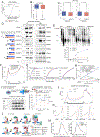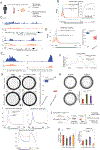Transcription elongation defects link oncogenic SF3B1 mutations to targetable alterations in chromatin landscape
- PMID: 38521065
- PMCID: PMC11061666
- DOI: 10.1016/j.molcel.2024.02.032
Transcription elongation defects link oncogenic SF3B1 mutations to targetable alterations in chromatin landscape
Abstract
Transcription and splicing of pre-messenger RNA are closely coordinated, but how this functional coupling is disrupted in human diseases remains unexplored. Using isogenic cell lines, patient samples, and a mutant mouse model, we investigated how cancer-associated mutations in SF3B1 alter transcription. We found that these mutations reduce the elongation rate of RNA polymerase II (RNAPII) along gene bodies and its density at promoters. The elongation defect results from disrupted pre-spliceosome assembly due to impaired protein-protein interactions of mutant SF3B1. The decreased promoter-proximal RNAPII density reduces both chromatin accessibility and H3K4me3 marks at promoters. Through an unbiased screen, we identified epigenetic factors in the Sin3/HDAC/H3K4me pathway, which, when modulated, reverse both transcription and chromatin changes. Our findings reveal how splicing factor mutant states behave functionally as epigenetic disorders through impaired transcription-related changes to the chromatin landscape. We also present a rationale for targeting the Sin3/HDAC complex as a therapeutic strategy.
Keywords: DNA damage response; R-loops; RNA polymerase II; SF3B1; Sin3/HDAC; U2AF1; WDR5; co-transcriptional splicing; spliceosome; transcription.
Copyright © 2024 Elsevier Inc. All rights reserved.
Conflict of interest statement
Declaration of interests Amit Verma has received research funding from Prelude, B.M.S., G.S.K., Incyte, Medpacto, Curis, and Eli Lilly; is a scientific advisor for Stelexis, Bakx, Novartis, Acceleron, and Celgene; receives honoraria from Stelexis and Janssen; and holds equity in Stelexis and Bakx.
Figures







Update of
-
Transcription elongation defects link oncogenic splicing factor mutations to targetable alterations in chromatin landscape.bioRxiv [Preprint]. 2023 Feb 26:2023.02.25.530019. doi: 10.1101/2023.02.25.530019. bioRxiv. 2023. Update in: Mol Cell. 2024 Apr 18;84(8):1475-1495.e18. doi: 10.1016/j.molcel.2024.02.032. PMID: 36891287 Free PMC article. Updated. Preprint.
References
MeSH terms
Substances
Grants and funding
LinkOut - more resources
Full Text Sources
Medical
Molecular Biology Databases
Research Materials

